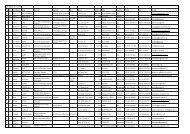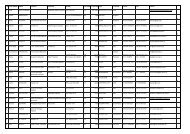icvg 2009 part I pp 1-131.pdf - Cornell University
icvg 2009 part I pp 1-131.pdf - Cornell University
icvg 2009 part I pp 1-131.pdf - Cornell University
Create successful ePaper yourself
Turn your PDF publications into a flip-book with our unique Google optimized e-Paper software.
— 51 —<br />
acquisition and analysis were performed with the ABI<br />
OneStep Plus software.<br />
control, based on shoot-tip culture of selected clones of<br />
Ideal and Aledo cultivars.<br />
RESULTS AND DISCUSSION<br />
The most sensitive method for detection of the<br />
assayed grapevine viruses resulted conventional real-time<br />
RT-PCR (using purified total RNA as template) followed<br />
by spot real-time RT-PCR and ELISA tests. These results<br />
show that real-time RT-PCR assays could be a valuable<br />
alternative to more traditional methods. The results of the<br />
analyses are summarised in Table 1.<br />
Table 1. Results of ELISA and Real time RT-PCR tets for the<br />
detection of seven grapevine viruses.<br />
Detection test<br />
Virus species<br />
Real-time RT-PCR<br />
ELISA<br />
Spot RNA<br />
GFLV 3/95* 12/95 45/95<br />
ArMV 0/95 0/95 0/95<br />
GLRaV-1 35/95 57/95 63/95<br />
GLRaV-3 61/95 66/95 90/95<br />
GFkV 25/95 46/95 62/95<br />
GVA 37/95 62/95 94/95<br />
GVB 7/95 23/95 42/95<br />
* number of positive samples/total samples<br />
The same plants will be tested in the future to<br />
calculate the reliability and accuracy of the positive and<br />
negative detections. A comparison of the percentage of the<br />
prevalence levels by ELISA, spot and conventional realtime<br />
RT-PCR are shown in Figure 1. The incidence of<br />
nematode-transmitted viruses ArMV and GFLV was quite<br />
different. Although the absence of ArMV was expected,<br />
the high incidence of GFLV detected by conventional realtime<br />
RT-PCR (47.30%) was dramatically higher than<br />
expected. Moreover, a comparison between real-time RT-<br />
PCR results with those obtained by ELISA test (3.26%),<br />
commonly used as detection method, suggests the poor<br />
sensitivity afforded by these ELISA tests and the necessity<br />
to improve the reliability of detection methods for sanitary<br />
programs. The prevalence of leafroll-associated viruses<br />
GLRaV-1 and GLRaV-3, was also very high, almost 100%<br />
for GLRaV-3. The prevalence was also very high for<br />
viruses associated with rugose wood complex (GVA and<br />
GVB) and GFkV. These results suggest that uncontrolled<br />
and/or initial infected plant material that scape to the<br />
control, was a key factor of these high prevalences. The<br />
high prevalence of viruses lead to in depth review of<br />
control programs in Vinalopó region. This study provides<br />
a backdrop and a reason to develop more efficient<br />
programs to control grapevine viruses in this economically<br />
important crop and region. A program to provide virusfree<br />
plant material has emerged as a cornerstone of virus<br />
Figure 1. Percentage of prevalence of seven grapevine<br />
viruses determined by ELISA, spot real-time RT-PCR and<br />
conventional (RNA) real-time RT-PCR.<br />
LITERATURE<br />
BERTOLINI, E., OLMOS, A., LÓPEZ, M.M. & CAMBRA M. 2003.<br />
Multiplex nested reverse transcription-polymerase chain reaction in<br />
a single tube for sensitive and simultaneous detection of four RNA<br />
viruses and Pseudomonas savastanoi pv. savastanoi in olive trees.<br />
Phytopathology 93, 286 – 292.<br />
BERTOLINI, E., MORENO, A., CAPOTE, N., OLMOS, A., DE<br />
LUIS, A., VIDAL, E., PANADÉS J. & CAMBRA, M. 2008.<br />
Quantitative detection of Citrus tristeza virus in plant tissues and<br />
single aphids by real-time RT-PCR. European Journal of Plant<br />
Pathology 120, 177-188.<br />
CAPOTE, N., BERTOLINI, E., OLMOS, A., VIDAL, E.,<br />
MARTÍNEZ, M.C. & CAMBRA, M. <strong>2009</strong>. Direct sample<br />
preparation methods for detection of Plum pox virus by real-time<br />
RT-PCR. Validation and practice parameters. International<br />
Microbiology (in press).<br />
LOHR, S.L. 2000. Muestreo: Diseño y análisis. International Thomsom<br />
Editores. México D.F. México.<br />
OLMOS, A., BERTOLINI, E., GIL, M. & CAMBRA, M. 2005. Realtime<br />
assay for quantitative detection of non-persistently transmitted<br />
Plum pox virus RNA targets in single aphids. Journal of<br />
Virological Methods 128, 151-155.<br />
OSMAN, F. & ROWHANI, A. 2006. A<strong>pp</strong>lication of a spotting sample<br />
preparation technique for the detection of pathogens in woody<br />
plants by RT-PCR and real-time PCR (TaqMan). Journal of<br />
Virological Methods 133, 130-136.<br />
OSMAN, F., LEUTENEGGER, C, GOLINO, D. & ROWHANI, A.<br />
2008. Comparison of low-density arrays, RT-PCR and real-time<br />
TaqMan RT-PCR in detection of grapevine viruses. Journal of<br />
Virological Methods 149, 292-299.<br />
ACKNOWLEDGEMENTS<br />
This study was su<strong>pp</strong>orted by RTA2008-00064 INIA and<br />
GVPRE/2008/051 Generalitat Valenciana projects. E. Bertolini is<br />
recipient of a Juan de la Cierva contract from Ministerio de Educación y<br />
Ciencia of Spain<br />
Progrès Agricole et Viticole, <strong>2009</strong>, Hors Série – Extended abstracts 16 th Meeting of ICVG, Dijon, France, 31 Aug – 4 Sept <strong>2009</strong>




